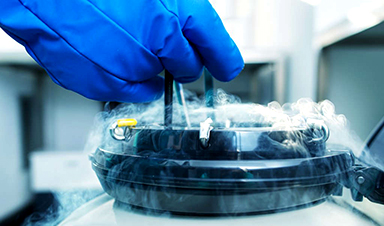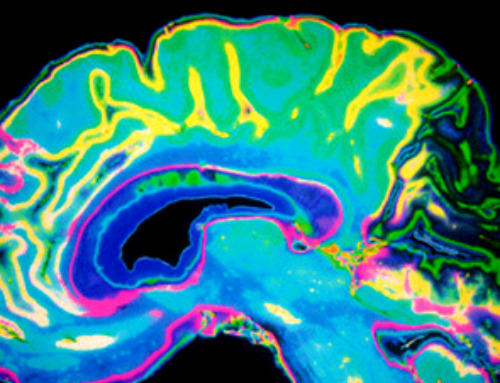"We wanted to really replicate what we see in the natural human body," Dr. Ryan Flannigan, a UBC urology assistant professor told Global News.
In a pair of world-firsts, the team of researchers, led by Flannigan, used a 3D printer to create viable testicular cells and identified early signs of sperm-producing capabilities.
In Canada, about one in six couples experience infertility. Thirty per cent of the time, the inability to conceive is related to the male partner and in some cases, it's not treatable.
The most severe form of male infertility is called obstructive azoospermia or NOA.
"It is a production problem in the testicle, where there is no sperm that is coming out into the ejaculate," explained Dr. Jesse Ory, assistant professor of urology at Dalhousie University. "Men often won't know because the volume in their ejaculate is often normal. But when you do a semen test, you don't see any sperm in the ejaculate fluid."
Toronto urologist Dr. Kirk Lo said NOA can be "congenital" or genetic but more common causes are chromosomal issues, trauma and toxic exposure (such as chemotherapy or radiation). Sometimes, the causes of testicular failure are unknown.
There are treatments but Lo said they can be invasive and ineffective.
"We can attempt something called microscopic testicular sperm extraction," explained Lo, "We open up the testes under a microscope and look for areas where we could potentially find sperm. It's really a last resort for these patients … the success at best is 50 per cent."
It's the patients Flannigan couldn't help, he said, who were the motivation for the project.
"It's really disappointing for myself and for the couples and patients when we don't have any options."
For the study, Flannigan and his team collected stem cells from a biopsy on the testicles of a patient living with NOA.
The cells were then cultured.
When they continued to show positive viability, they were 3D printed onto a petri dish into a hollow tubular structure that resembles the sperm-producing seminiferous tubules.
Twelve days later, the cells had not only survived but thrived.
"We got to the middle stage of sperm production," Flannigan explained.
Dr. Amin Herati, a urologist at Johns Hopkins Hospital told Global News the research is a "game-changer" for men living with NOA.
"When you take that hope away from patients, where they can't have kids and tell them there is no option and then you bring forward an option such as what Dr. Flannigan is proposing, that could make a huge difference in the world of fertility," said Herati.
Flannigan said there are still several years of research ahead and testing to do before his work is put into clinical practice.
"This is really the starting point for our research," he said.
Now, the goal is to "coach" the printed cells into producing sperm. The group will do this by exposing cells to different nutrients and growth factors, as well as perfecting the structural arrangement.
If successful, the sperm could be used to fertilize an egg through in vitro or IVF, giving more men the chance at becoming biological fathers.
"Being able to have a family is something that's pretty important," said Ory. "The more technology that we get that can allow us to do that, you know, I'm all for it."
Dr. Flannigan's research program may also help unravel the reasons some men suffer from NOA.
"The whole idea is you could potentially use these kinds of test models to understand the underlying pathology which may help you target treatments," said University of Toronto urology professor Dr. Keith Jarvi.
"If you have an understanding of why these men have a production problem, you could also potentially avoid it in the future."
News
Researchers highlight five pathways through which microplastics can harm the brain
Microplastics could be fueling neurodegenerative diseases like Alzheimer's and Parkinson's, with a new study highlighting five ways microplastics can trigger inflammation and damage in the brain. More than 57 million people live with dementia, [...]
Tiny Metal Nanodots Obliterate Cancer Cells While Largely Sparing Healthy Tissue
Scientists have developed tiny metal-oxide particles that push cancer cells past their stress limits while sparing healthy tissue. An international team led by RMIT University has developed tiny particles called nanodots, crafted from a metallic compound, [...]
Gold Nanoclusters Could Supercharge Quantum Computers
Researchers found that gold “super atoms” can behave like the atoms in top-tier quantum systems—only far easier to scale. These tiny clusters can be customized at the molecular level, offering a powerful, tunable foundation [...]
A single shot of HPV vaccine may be enough to fight cervical cancer, study finds
WASHINGTON -- A single HPV vaccination appears just as effective as two doses at preventing the viral infection that causes cervical cancer, researchers reported Wednesday. HPV, or human papillomavirus, is very common and spread [...]
New technique overcomes technological barrier in 3D brain imaging
Scientists at the Swiss Light Source SLS have succeeded in mapping a piece of brain tissue in 3D at unprecedented resolution using X-rays, non-destructively. The breakthrough overcomes a long-standing technological barrier that had limited [...]
Scientists Uncover Hidden Blood Pattern in Long COVID
Researchers found persistent microclot and NET structures in Long COVID blood that may explain long-lasting symptoms. Researchers examining Long COVID have identified a structural connection between circulating microclots and neutrophil extracellular traps (NETs). The [...]
This Cellular Trick Helps Cancer Spread, but Could Also Stop It
Groups of normal cbiells can sense far into their surroundings, helping explain cancer cell migration. Understanding this ability could lead to new ways to limit tumor spread. The tale of the princess and the [...]
New mRNA therapy targets drug-resistant pneumonia
Bacteria that multiply on surfaces are a major headache in health care when they gain a foothold on, for example, implants or in catheters. Researchers at Chalmers University of Technology in Sweden have found [...]
Current Heart Health Guidelines Are Failing To Catch a Deadly Genetic Killer
New research reveals that standard screening misses most people with a common inherited cholesterol disorder. A Mayo Clinic study reports that current genetic screening guidelines overlook most people who have familial hypercholesterolemia, an inherited disorder that [...]
Scientists Identify the Evolutionary “Purpose” of Consciousness
Summary: Researchers at Ruhr University Bochum explore why consciousness evolved and why different species developed it in distinct ways. By comparing humans with birds, they show that complex awareness may arise through different neural architectures yet [...]
Novel mRNA therapy curbs antibiotic-resistant infections in preclinical lung models
Researchers at the Icahn School of Medicine at Mount Sinai and collaborators have reported early success with a novel mRNA-based therapy designed to combat antibiotic-resistant bacteria. The findings, published in Nature Biotechnology, show that in [...]
New skin-permeable polymer delivers insulin without needles
A breakthrough zwitterionic polymer slips through the skin’s toughest barriers, carrying insulin deep into tissue and normalizing blood sugar, offering patients a painless alternative to daily injections. A recent study published in the journal Nature examines [...]
Multifunctional Nanogels: A Breakthrough in Antibacterial Strategies
Antibiotic resistance is a growing concern - from human health to crop survival. A new study successfully uses nanogels to target and almost entirely inhibit the bacteria P. Aeruginosa. Recently published in Angewandte Chemie, the study [...]
Nanoflowers rejuvenate old and damaged human cells by replacing their mitochondria
Biomedical researchers at Texas A&M University may have discovered a way to stop or even reverse the decline of cellular energy production—a finding that could have revolutionary effects across medicine. Dr. Akhilesh K. Gaharwar [...]
The Stunning New Push to Protect the Invisible 99% of Life
Scientists worldwide have joined forces to build the first-ever roadmap for conserving Earth’s vast invisible majority—microbes. Their new IUCN Specialist Group reframes conservation by elevating microbial life to the same urgency as plants and [...]
Scientists Find a Way to Help the Brain Clear Alzheimer’s Plaques Naturally
Scientists have discovered that the brain may have a built-in way to fight Alzheimer’s. By activating a protein called Sox9, researchers were able to switch on star-shaped brain cells known as astrocytes and turn them into [...]





















